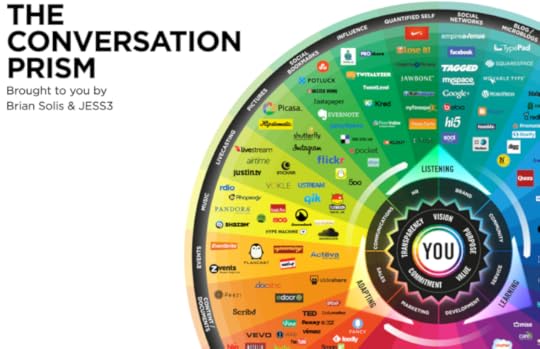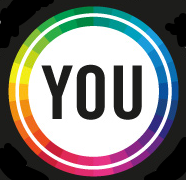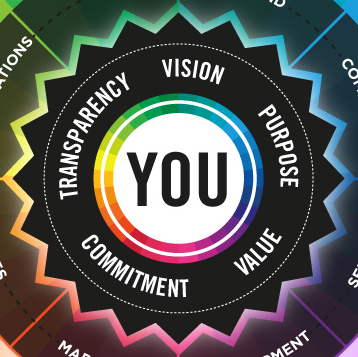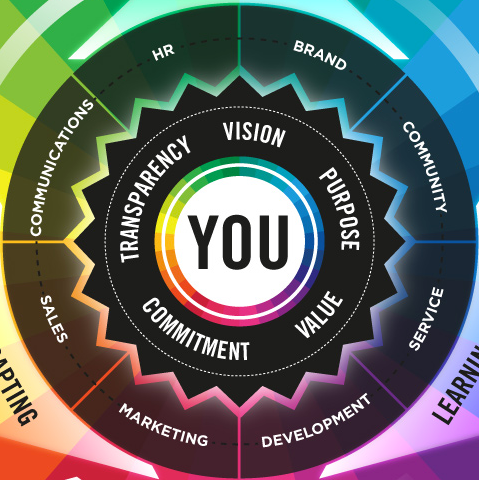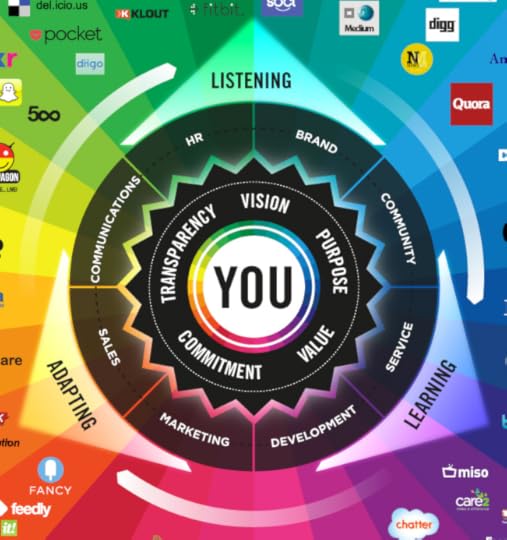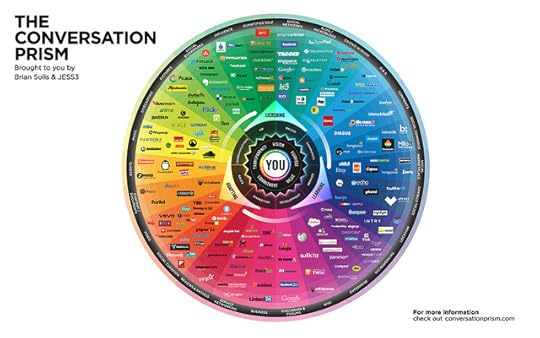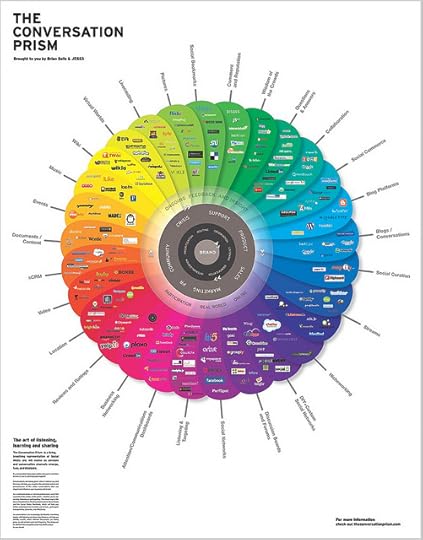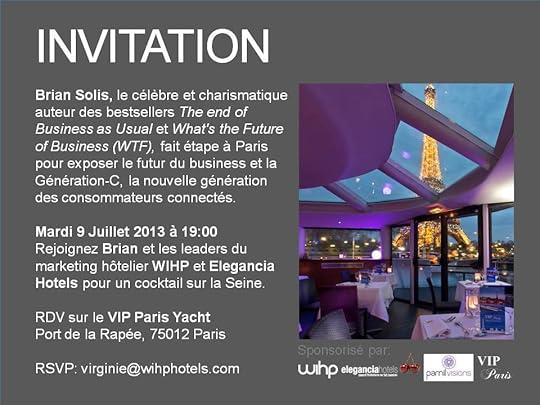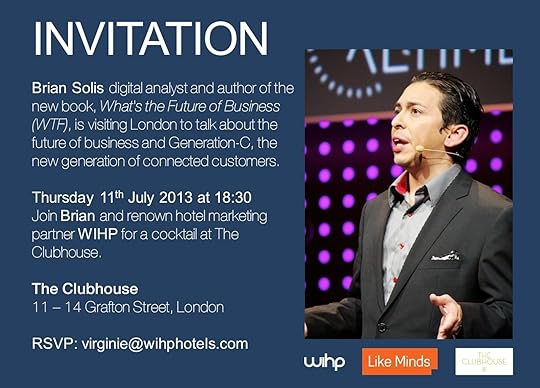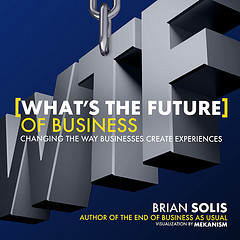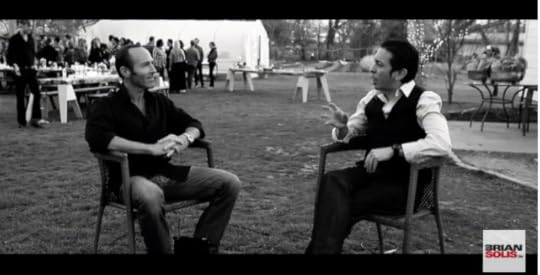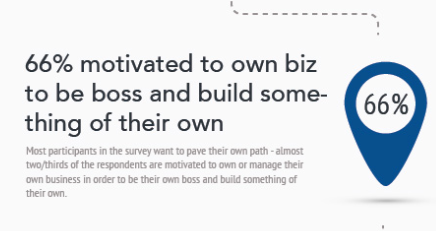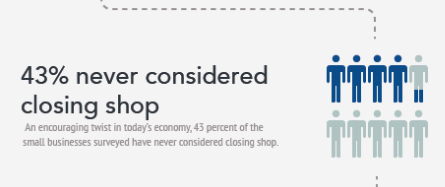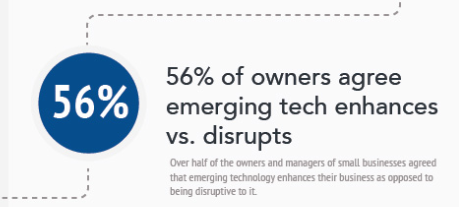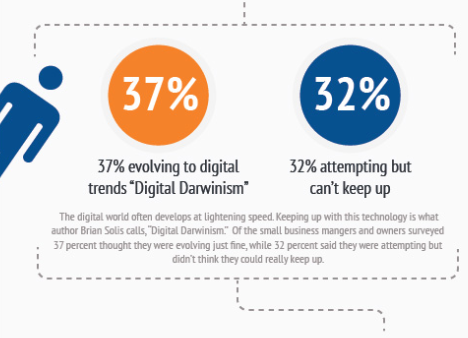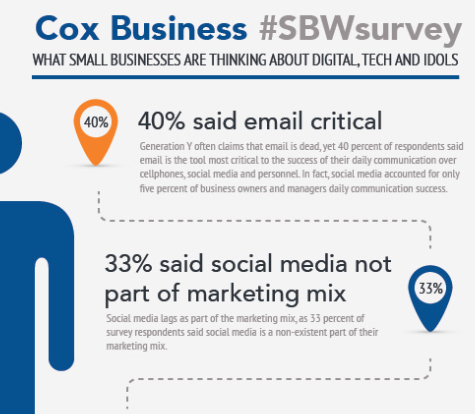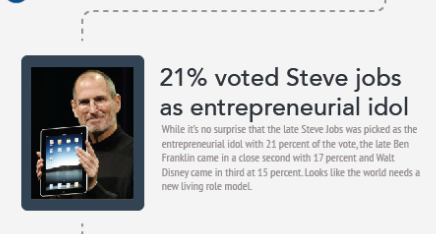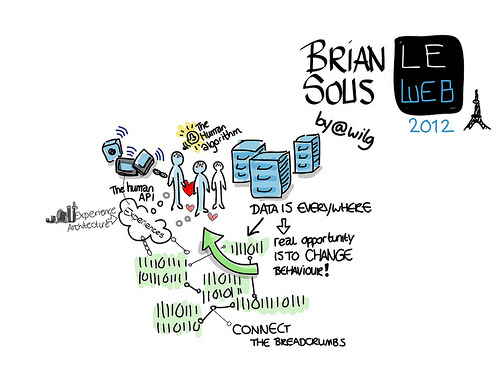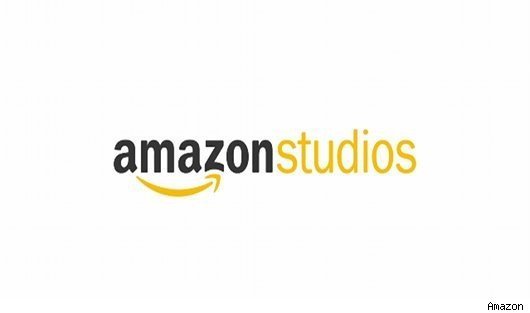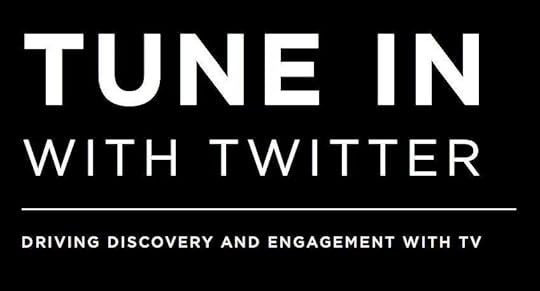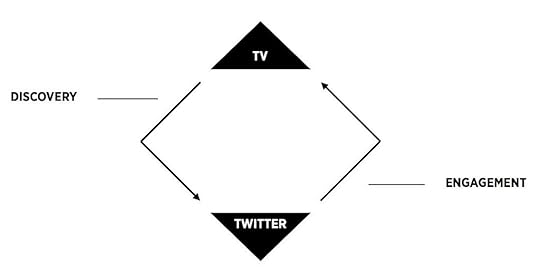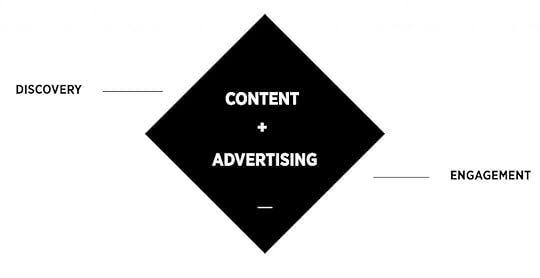Brian Solis's Blog, page 118
July 16, 2013
YOU are at the center of The Conversation Prism
JESS3 and I debuted versions 4.0 and 4.1 of The Conversation Prism (TCP) recently to an overwhelming response. Thank you. The initial post was intended to share the evolution of the popular infographic along with the transformation of the social landscape over all. Over the years, new startups, sunsets, acquisitions, mergers, and shifts in trends and technology have played out in true Shakespearean fashion, which has made for truly dramatic theater.Excietment and turmoil aside, The Conversation Prism is in of itself, one of the industry’s most comprehensive visual studies of how we use networks and how that changes over time.
Since the latest iteration, which by the way comes almost two-and-a-half years following the release of version 3.0, interesting conversations and debates continue to bloom. I believe this interaction is healthy and it only helps an industry straddled with confusion and also opportunity, to better understand how to move in a meaningful direction. I’d like to share a few thoughts on this front…
1) It was not intended to over-complicate social media.
2) It is not designed to exclude any service, merely represent behavior and some of the promising networking within each category.
3) It is not meant to be all-inclusive. In fact with 4.0, we’ve sparked development of new TCP’s to focus on important vertical markets. If you have thoughts or feedback, please provide them in the comments section. I listen.
4) Taking issues with an individual spectrum is welcome. But I challenge you to think about intention and the CENTER of the prism to make the conversation more productive rather than a debate that is out of context from the onset.
5) This is designed to help you. Downloads in various sizes and shapes are available freely for you to download and share. Take your pick here. Because many have asked, it was also printed as a high-quality 22 x 28 poster. You can order it here.
6) And, yes…it’s unfortunate that the word Prism also means something else now. However, it is what it is. In many ways the irony is too great to abandon.
In the very least, The Conversation Prism represents an ongoing exploration in digital ethnography providing a unique snapshot in time of the social landscape dating back to 2007/2008. Comparing each version will provide an excellent foundation for historical research. It’s a catalyst for analysis, dissection and most importantly, interpretation and conversation.
At the center of all of this is YOU and that’s what I’d like to focus on today.
Getting to the Heart of The Conversation Prism
The hub of The Conversation Prism is comprised of four concentric circles that visualize a continuous cycle of renewal. Each halo builds upon the other to advance strategies and intentions as we experiment, learn and improve.
Halo 1: Bringing it Home: The Brand YOU
The center of TCP is literally “you.” This was intentional and true going back to version 1.0. You have no business creating a presence in every network. You should only manage a presence where it’s warranted. Whether you’re merely listening or building communities, the idea was to explore your opportunities beyond the usual suspects (Facebook, Twitter, Youtube, Instagram, Pinterest, Vine, et al.) and find the networks where you can gain or introduce value.
Value is to be defined however as it’s not solely relegated to traditional ROI. Brand resonance or equity, relationships, reciprocity, thought leadership, intelligence, etc., are all on the table.
Halo 2: Vision. Purpose. Value. Commitment. Transparency.
Once you’ve defined the YOU and the role you play or wish to play in social, consider the pillars for meaningful engagement.
Vision – What is your vision for social media and how would you articulate it to your executives and stakeholders.
Purpose – What is the motivation or grounds for social media and how can it be justified against other investment opportunities?
Value – Social and relationships involve more than one party and value must be mutual. What is the value you intend to deliver and how will you assess and communicate value?
Commitment – Before you invest in social, understand the commitment necessary to provide and gain value as you scale. Allocate accordingly.
Transparency – This is an era of business where information isn’t only democratized, networks and nodes are becoming human. It’s essential that all of the pillars above are communicated and enlivened in all you do and say.
Halo 3: Brand, Lines of Business, and Corporate Functions
Social is not a silo or a function, it is a way of business. It is intended to mature business perspective from a command and control mentality to that of engagement and openness. As such, it’s bigger than marketing, it affects employees, customers, and all of the processes and systems that exist between them.
Halo 4: Always Be Improving (ABI) – Listen. Learn. Adapt.
Often, there’s what you want to talk about and what they (customers and employees) want to talk about. Mutual value lies somewhere in the middle. It’s often said that the best listeners make the best conversationalists. The last stage in the center of The Conversation Prism reminds us of the importance of listening. In doing so, we learn and adapt to improve all that we do inside and outside the company.
Each of the concentric circles is designed to work together, to help you improve strategies and results to improve the way you work, how you build relationships with employees and customers, the ability to create and improve better products, services and experiences, and overall, the role you play and the stature you earn as a result.
For more, please visit theconversationprism.com.
Free downloads.
Get the poster.

July 8, 2013
The 2013 Social Media Landscape [Infographic]
After almost two-and-half years, it is with great pleasure that I officially unveil the fourth edition of The Conversation Prism. Viewed and downloaded millions of times over, The Conversation Prism in its various stages has captures snapshot of important moments in the history and evolution of Social Media.
For those unfamiliar with The Conversation Prism, it is an evolving infographic that captures the state of social media, organized by how important social networks are used by professional and everyday consumers. It was created to serve as a visual tool for brands to consider unforeseen opportunities through a holistic lens. Over the years, it has served as a business tool as well as art decorating the walls and screens of offices, conference halls, and also homes.
With research beginning in 2007, the original Conversation Prism debuted in 2008 as a visual map of the social media landscape. Years and four iterations later, it remains an ongoing study in digital ethnography that tracks dominant and promising social networks and organizes them by how they’re used in everyday life.
It is provided as a free download in many sizes and shapes here.
Why is The Conversation Prism More Than a Pretty Infographic?
The Conversation Prism is important because it is the ONLY research-driven map that explores the evolution of the social web dating back to the rise of social media.
It is a combination of research and digital ethnography. It groups networks by how people use them. It includes both leading and promising networks. It’s not intended to show every network, but instead how the shape of the social web is changing and who the front runners are pushing social media in new directions.
The Conversation Prism was designed to help strategists see the bigger picture in the evolution of social media beyond the most popular and trendy sites. It is intended to help in a number of ways…
1. As a form of validation to show executives that social media is not a fad and that it’s bigger than Facebook, YouTube, Twitter, and Pinterest.
2. To motivate teams to find new ways to think about social media and explore new ways to improve experiences and relationships.
3. Provide a top-level view to help strategists study the landscape as they plan their next social media strategy.
History: When were the previous versions released?
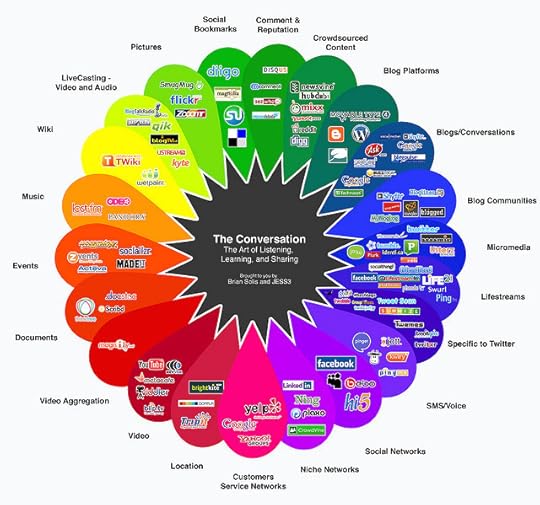
1.0 = August 2008 (pictured above)
2.0 = March 2009
3.0 = October 2010
4.0 = July 2013
What’s new with Version 4.0?
Version 4.0 is the latest update in the two-and-half years since 3.0 (pictured above) was introduced in 2010. It also features an entirely new design.
Version 4.0 brings about some of the most significant changes since the beginning. In this round, we moved away from the flower-like motif to simplify and focus the landscape.
With all of the changes in social media, it would have been easier to expand the lens. Instead, we narrowed the view to focus on those that are on a path to mainstream understanding or acceptance.
The result was the removal of 122 services while only adding 113. This introduces an opportunity for a series of industry or vertical-specific Prisms to be introduced.
Overview of Categories Added:
1. Social Marketplace
2. Enterprise Social Networks (shortened to “Enterprise” for formatting, companies included here were previously grouped under “Nicheworking”, which we redefined.)
3. Influence
4. Quantified Self
5. Service Networking
Categories Removed
1. Virtual Worlds
2. Blogs/Conversations
3. sCRM
4. Attention/Communication Dashboards
5. DIY + Custom Social Networks
6. Collaboration
Why is it Called a Conversation “Prism?”
I get this question all the time. And in light of activity related to the NSA, Prism takes on an entirely new meaning. Additionally, the Conversation Prism is often referred to as a color wheel, but to do so, takes away from it’s the beauty of its design and purpose.
Using a “prism” metaphor was intended figuratively and literally…
Using the traditional definition, a prism separates white light into a spectrum of colors. The “white light” in this case, is the focused stream of conversations that are often grouped, but not separated by voice, context, source, or outcome. We take this beam of dialog and blast it into a spectrum of discernible light, let’s call it enlightenment, to see, hear, learn and adapt. We quite literally bring conversations to light. Used figuratively, it references the clarification or distortion afforded by a particular viewpoint…for example, “We view conversations across the networks through the prism of our social dashboard.”
Each shade of color represents an entirely unique reflection of light, meaning separating context and intention by network.
Original designs refracted the light of conversations vertically, like so many traditional prism images you see. But, as the social web grew, we shaped the refracted light into a circle to help everyday people understand that the days of one audience, one voice, one story were over. We now had to envision, organize, and understand that conversations take place in communities that we don’t yet realize…obviously far beyond Facebook and Twitter.
The Age of Context: Context is King!
The social landscape is evolving with increasing acceleration. As you can see throughout every iteration of the Prism, the number of networks that vanish and emerge is staggering. But more importantly, the nature and focus of how networks are used is also dramatic in its changes. In some cases we see the move to smaller or more concentrated networks and at the same time the visual “social” web is becoming more pervasive. We are moving into an era of context where what we share, how we interact and how we form relationships is moving away from a general social graph to a distributed yet organized network defined by shared interests.
The Conversation Prism is available as a poster for $20 or as a free digital download in a variety of resolutions and sizes. 4.0 is available exclusively at www.conversationprism.com
For more, please visit:
Mashable
The Next Web
All Twitter
LaughingSquid
Cool Infographics
Alltop

July 4, 2013
Your invitation to events in Paris and London
These last few months have certainly been a wonderful whirlwind. With the debut of What’s the Future of Business (WTF), a research report co-produced with Altimeter Group colleague Charlene Li (The Evolution of Social Business: Six Stages of Social Media Transformation), and the roll out of the all new Conversation Prism (v 4.0), I’ve been inspired by all of your support each step of the way. Thank you.
It is with great privilege that I announce a special book tour in Paris and London July 8th to the 15th. To mark the occasion, there are several events that I’d like to share with you. RSVP information below…
PARIS
July 9th – 19h-21h – VIP Paris Yacht
A floating networking + cocktail reception on the Seine.
Hosted in partnership with WIHP (a premier hotel marketing agency), Elegancia Hotels (I’m staying at Hotel Armoni) and VIP Paris, we will toast to you and the future of business!
VIP Paris Yacht: Port de la Rapée, 75012 Paris
Please RSVP: virginie@wihphotels.com
July 10th – 18h30 – 20h – Paris
A private salon where I will present themes and findings from WTF. Attendees will receive a complimentary copy of the book. This exclusive event is sponsored by SFR and hosted by Béatrice Duboisset of TweetBosses and Francois Vogel
Please request an invitation.
LONDON
July 11th – 18h30 – The Clubhouse London
Join us at the style Clubhouse for a cocktail reception at 18h30. Organized by WIHP, LikeMinds, The Clubhouse and hosted by the lovely Gabrielle Laine-Peters, we will celebrate the evolution of new media and business and our role in defining its future!
Please RSVP: virginie@wihphotels.com
July 12th – 9:00 – Adobe, May Fair Hotel, London
Adobe hosts an exclusive event for brands and agencies where I’ll speak about What’s the Future of Business and the rise of the connected customer. It’s also an opportunity to ask any questions you may have.
We’ll also discuss…
- How leadership can survive Digital Darwinism
- The Four Moments of Truth
- Navigating the evolving landscape of new consumerism
- How to align user experience with innovation and leadership to improve business performance and engagement
Space is strictly limited to 200 by invitation only. The first 100 to register will also receive a copy of WTF.
Please RSVP.
July 12th – 18h45, B2B Huddle
Sponsored by Dell and hosted by Microsoft, the B2B Huddle will comprise a blend of listening and learning alongside meeting and speaking, plus a strong element of social with a light dinner and drinks. The event is organized by Neville Hobson and Kerry Bridge.
I will share highlights from WTF, explain the evolution of the B2B customer journey and also answer your questions.
Please RSVP here.
Thank you
I do hope to see you at one or more of these events!
None of this would be possible without the help of amazing people of course. I would like to take a moment to send a very special, heartfelt thank you to…
Phil Butler, Pamil Visions
Martin Soler, WIHP Hotels
Francois Vogel, Textuel La Mine
Pascale Azria, Kingcom
Jeremy Waite, Adobe

June 25, 2013
SnapChat Targets Tweens with SnapKidz – Hide your kids, hide your wife, hide your husband…
Snapchat has yet to show any signs of self-destructing. In fact, it’s blowing up. Nielsen recently reported that Snapchat had more than 8 million unique users in May 2013 with adults on Nielsen’s U.S. panel accessing the app on average 34 times that month. Snapchat now sees 200 million snaps exchanged per day, up from 60 million in February. According to my good friend Jennifer Van Grove at CNET, that places Snapchat in the league of the majors. Facebook for example,sees 350 million photo uploads per day.
The young company also recently snapped up $60 million from Institutional Investment Partners at an $800 million valuation. Yes, it’s close to joining the billion dollar club. In this round, the company’s cofounders, Evan Spiegel and Bobby Murphy, reportedly sold personal shares in a secondary offering at $20 million or $10 million each.
Now You See Me, Now You Don’t – From SnapChat to SnapKidz
As the network continues to mature, it must explore new tools and services to help ease concerns of a provocative subculture that knows no age limit. To do so, SnapChat introduced SnapKidz, an age-gated version for honest users (aka kids or tweens) under 13. I shared some of my thoughts on the new app with Joanna Stern over at ABC News. I’ve shared part of the discussion below…
SnapKidz is a clever app and an even more ingenious solution to address Generation Z. SnapKidz is embedded within Snapchat and unlocks automatically when children indicate that their age is in fact under 13. The modified app however doesn’t allow younger children to sure pictures however. But, they’re permitted to capture pictures and add captions and drawings to each. I’m sure it’s fun in its own way and of course, kids will find a way to share them. They will not self-destruct however.
Generation Z is an important market for the future of mobile and social networking. If we thought that Millennials were digital natives, Generation Z will make everyone blush. Providing them with an app is part branding and part CYA. While popular, Snapchat is also synonymous with adult-like interactions that really are meant to self-destruct. To comply with COPPA (the Children’s Online Privacy Protection Act), Snapchat offers a proactive age-gate fix for kids interested the app with safety nets built in for those who tell the truth. This is noteworthy and important. Not only are kids prevented from sharing, they are also protected from receiving explicit content from older kids and adults.
While I believe that many children will use the app, I also believe that kids will be kids. The appeal of Snapchat isn’t the ability to take pictures and caption or draw on them. The attraction is the self-destruct feature which naturally begets curiosity.
Be warned however. Treat Snapchat as if the pictures you share can find a way online. There are always interesting ways discovered to take a screenshot of a supposedly self-destructing picture. My advice here is to parents…please check your kid’s phones. They need supervision and guidance. And, parents also need to be aware. Just because they don’t understand this world doesn’t excuse the fact that these new worlds exist. Let’s not forget that Instagram is taking off among Generation Z not because it was “safe,” but instead because parents initially mistook the thriving social network as a simple camera app.
Yes…you can find me on Snapchat.
Connect with me: Twitter | LinkedIn | Facebook | Google+ |Youtube | Instagram

June 20, 2013
Doing Good Means Good Business: Peter Glatzer and Adrian Grenier Make SHFT Happen
Conversations about the environment and sustainability are important. But, there may be a prevailing sense that those doing the talking might inadvertently create an “us versus them” conversation. Instead, there is an opportunity to consider everyday lifestyle center point to then examine how the choices we make impact society from a personal point of view. Lifestyle is also something that’s aspirational and as such, requires an ecosystem to inform and empower our everyday decisions without reproach.
“SHFT Environmentalists Say”
SHFT is not just another site about becoming environmentally friendly or promoting sustainability. Those are antiquated and anachronistic according to co-founder and indie film producer Peter Glatzer. Instead, when Glatzer along with Entourage star Adrian Grenier discussed the original idea, the duo set out to shift how people today embrace and promote positive changes in consumer and lifestyle behavior.
Instead of launching just another blog or online network dedicated to environmentalism, Glatzer and Grenier invested in building a digital media platform where people can read, watch, shop and share all things sustainable. Today, it’s a thriving community to explore and share products and ideas appealing to non-treehuggers.
While at SXSW 2013, I spent some time with Glatzer at the official SHFT party hosted at Springdale Farm in Austin. We discussed SHFT, its future, as well as the debut of the new label of SHFT’s sustainable wines.
“We don’t think of ourselves as a movement. When you look at environmentalism, it’s ghettoized. What we’re trying to do is fold the idea of being conscious about the environment into everything we do in life…all the choices we make in life.”
Subscribe to BrianSolisTV here.

June 18, 2013
Small Business Survey: Technology a Challenge and Opportunity, Steve Jobs Recognized as Idol
Did you know that the 23 million small businesses in America account for 54% of all U.S. sales?
Did you know that small businesses provide 55% of all jobs and 66% of all net new jobs since the 1970s?
While big business has eliminated four million jobs since 1990, small businesses added eight million.
Why the focus on small business today? It’s National Small Business Week in the United States and to commemorate the occasion, I partnered with Cox Business to discuss the importance of connected consumerism amidst the release of its inaugural small business survey (#SBWSurvey).
Available at CoxBLUE.com, The #SBWSurvey was conducted nationwide among 605 small business owners. The findings were intended to help business owners and aspiring entrepreneurs gain perspective on the state of small business and to better understand what’s on the minds of their peers.
Let’s jump in…
When asked why people started a business in the first place, two-thirds set out on their own path to become the boss. They were inspired by the freedom of owning their own business or the idea of building something of their own. After all, that’s what entrepreneurialism is all about.
Even during the darkest days of this tumultuous economy, a strong number of businesses never considered closing shop. In fact 43% stayed true to their vision, embraced courage, and buckled up for the wild ride.
So often in my experience, business owners and managers, of any size, tend to underestimate new technology and overestimate their product or service as a means to growing their business. This is simply not the case and according to the Cox Business survey, 56% believe that emerging technology can only enhance business rather than disrupt it. With that said however, all isn’t clear in how to embrace new technology or exactly why for that matter.
The survey introduced the concept of Digital Darwinism to small business owners. For those who are unfamiliar with the term, it’s the phenomenon I explored in depth in The End of Business as Usual and What’s the Future of Business. Digital Darwinism happens when technology and society evolve faster than the ability to adapt. To see just how big of a deal it is, take a look at this infographic.
The rate of innovation and new technology is only accelerating. I was pleased (or relieved) to learn that 37% of small businesses feel that they’re evolving along with digital trends. However, another third feel that they were attempting to but didn’t think they could really keep up with the tsunami of new communities, networks, apps, and devices.
Perhaps feeling overwhelmed is a symptom of the reality we choose to see. If we choose to live in our comfort zone and see business opportunities as the proverbial glass that’s half empty, we are prone to already see things from a negative perspective. On the other hand, new technology opens new channels, which creates new touch points. And, as we learned in Google’s Zero Moment of Truth, connected customers, or Generation-C as I refer to them, will refer to as many as 11 sources to discover products, services and information during the decision-making cycle. This is a number that has doubled year over year.
One of the most troubling stats from the report though was the number of small businesses that rely on email as the tool most critical to the success of their daily communication. While email may represent a vital conduit between small businesses and traditional customers, it certainly doesn’t signify the future when considering how Generation-C prefers to connect. It’s akin to relying on fax and The Yellow Pages in a time when a generation exists that has either never touched or seen either in real life.
Equally striking was the number of businesses (one-third) that do not use social media AT ALL as part of their marketing mix. Considering that web sites, even today, are largely useless, broken, or ineffectively design (or all of the above), social media represents a more efficient and human way of connecting with customers, where conversations and community can provide utility and foster goodwill. Reciprocity converts to acquisition better than the conversion rates of a generic email blast…I assure you.
Small business owners were also asked to reveal their entrepreneurial idol. I smiled when I saw two my top three make the list. At number one, Steve Jobs accounted for 21%. Believe it or not however, Ben Franklin came in second with 17%. And, running a close third was Walt Disney with 15%.
Certainly Steve Jobs is up there in that he built Apple from the ground up of course, but also he ran it at its height as a passionate entrepreneur. Across the board, Jobs, Franklin, and Disney embraced the importance of experience through invention, innovation, and passion. These are three traits that are vital to success regardless of the economy or the state of technology. Living life, building businesses, not from templates or best practices, but instead as blank canvases, opens doors to new opportunities.
As I’ve always believed, constraint forces creativity. And, that’s the point.
Technology isn’t going away. It’s not a fad. We are not going back to the good old days. In fact, we’re living the good old days right now. It’s time to move away from our comfort zones or positions of convenience. It’s time to allow curiosity to trump skepticism. It’s time to embrace the unknown to realize everything we need to know.
This is our time…and what an exciting time it is. These are the days that the future of business is either written or getting re-written.
Read the survey and view the infographic at CoxBLUE.
The story continues…
Connect with me: Twitter | LinkedIn | Facebook | Google+ |Youtube | Instagram
Image Credit: Shutterstock

June 13, 2013
Disruptive Selection: Nature’s Way of Weeding Out the Average Business
Disruption!
It’s everywhere. I live in Silicon Valley where many say that the terms disrupt and disruption have become buzzwords. Pundits believe that the word is losing its promise and impact through the acts and examples of entrepreneurs and businesses that misuse the word to describe intentions rather than associating it with a desired or natural effect.
In some of the startup meetings I attend for example, digital disruption is actually a stated business objective. Instead of “killing it” or “crushing it” many businesses are aiming now to disrupt it!
Kidding aside, disruption is more than a buzzword of course. It is a term that is becoming an important part of everyday business to describe what is happening to and around markets and ultimately companies everywhere. While it may be a genuine goal, disruption is the act of disturbing or interrupting the norm and its effect is measured by the the following series of events that unfold.
Like it or not, disruption is a natural part of life. I refer to this phenomenon as Digital Darwinism, when society and technology evolve faster than the ability to adapt. Every so often something comes along and completely upsets the norm. And this is only accelerating. Either you’re disrupting or you’re at risk of getting disrupted.
Continuing the Digital Darwinism metaphor, businesses, like nature itself, are open to natural selection. One of the three common forms of natural selection (including directional and stabilizing selection) that I’d like to explore is that of disruptive selection, which selects against the mean of the population. Adapting the definition to suit the purpose of this discussion, disruptive selection singles out average businesses in any given population making room for speciation, the formation of new and distinct species in the inevitable course of evolution.
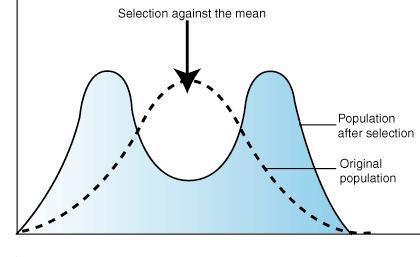 In my research on disruptive selection, I found several references to London’s peppered moths. H.B.D. Kettlewell, an English physician set out to study the unexplained color variations of the peppered moth in the 1950s. Kettlewell set out to better understand why in the industrialized areas of Britain, the peppered moth population evolved from light gray-colored individuals to that of primarily of dark gray species. In rural areas, the peppered moths were predominately light in color. Kettlewell learned that darker moths survived predators in the industrial areas by blending in to polluted environments. The lighter moths stood out and were seen easily by predators. In rural areas, the opposite would occur.
In my research on disruptive selection, I found several references to London’s peppered moths. H.B.D. Kettlewell, an English physician set out to study the unexplained color variations of the peppered moth in the 1950s. Kettlewell set out to better understand why in the industrialized areas of Britain, the peppered moth population evolved from light gray-colored individuals to that of primarily of dark gray species. In rural areas, the peppered moths were predominately light in color. Kettlewell learned that darker moths survived predators in the industrial areas by blending in to polluted environments. The lighter moths stood out and were seen easily by predators. In rural areas, the opposite would occur.
In the realm of digital disruption, disruptive selection opens the door to creative destruction, which is set to unleash up every industry imaginable. As Joseph Schumpeter noted in, “Capitalism, Socialism and Democracy” published in 1942, creative destruction is the process of industrial mutation that incessantly revolutionizes the economic structure from within, incessantly destroying the old one, incessantly creating a new one. Said another way, there’s always going to be instances where new kills old or the the old evolves into something new.
Let’s take Uber for example as a form of disruptive selection. Who here loves taking taxis? I’m often in San Francisco and New York and the experience that I have is often poor. Cars don’t stop to pick you up. When they do, cars are often dirty, drivers are frequently less than pleasant, and the goal of getting from point A to B is generally by way of creative way points.
As a result, I’m a big fan of Uber as is anyone who uses the service.
For those unaware of Uber, it was founded in 2009 by Garrett Camp, Travis Kalanick and Oscar Salazar as an on-demand mobile platform that connects passengers to available drivers. The app shows passengers available cars, the distance/time to them, an estimated price based on their destination and an integrated payment system so that you can simply step out of the vehicle rather than doing the oft uncomfortable dance of remittance. More importantly, Uber introduces a human touch, giving passengers the ability to rate drives and also learn more about each driver and the experiences other Uber users have shared for each. This is important because it introduces a shift in the value proposition.
Each time I get into an Uber car, I interview the driver to learn more about why they use Uber. The story is often the same. As you would guess, money is part of the equation, but so is service. Each driver has their own process of greeting passengers and ensuring that their ride is clean, pleasant and personalized. Those who don’t get it…don’t get it and it’s clear in their reviews. PASS!
At a minimum through, Uber offers black car or luxury car operators to expand their customer base when their in between jobs. The price is often comparable to that of a standard cab and as you can imagine taxi operators are not in love with Uber. Essentially, Uber is disrupting the taxi industry and this has regulators up in arms as they flail to protect their way of life.
Rather than fixing the taxi industry’s problems or setting out to improve passenger experiences, regulators and officials instead cry foul and attempt to block Uber in each city it introduces. WTF!? If anything, that’s a response worthy of Digital Darwinism and a strong example of disruptive selection in action. If you have a choice, the decision is easy. And over time, unless the taxi industry innovates to compete, companies such as Uber and Sidecar will at come point become the norm. To date, Uber is now in 29 cities internationally and was recently awarded Fast Company’s “2013 Most Innovative Company in Mobile.”
Disruption eventually gives way to models and templates for others to follow. Eventually however, disruption evolves into business as usual until it is disrupted again through a process of disruptive selection. Reacting to disruption may already be too late. Setting out to improve experiences and outcomes and finding innovative ways to do so is your only answer. And, this is something that becomes part of everyday business.
Setting out to disrupt markets is commendable, but to compete for the future takes more than intent to disrupt, it takes vision to see what others cannot and perseverance to do what others cannot or will not. The best investment you can make in business is the quality and experience of your product for it is the experience that people will document and share. In a connected economy, those shared experiences become the trusted leverage other consumers seek to make informed decisions.
Every threat has its antagonist. Disruption is only thwarted, or also fueled by, innovation.
#InnovateorDie
The story continues…
Connect with me: Twitter | LinkedIn | Facebook | Google+ |Youtube | Instagram
Image Credit: Shutterstock

June 4, 2013
Plugging into the Future of Humanity: Exploring the Human API
I had the opportunity to present at LeWeb in Paris, arguably Europe’s largest conference dedicated to the future of technology. The theme of the conference explored the Internet of Things, where devices and things connect to one another to perform certain tasks and/or track activities to improve what we already do or make possible what we’re trying to do.
The Internet of Things is bigger than we may realize. We are experiencing a shift from a world of inanimate objects and reactive devices to a world where data, intelligence, and computing are distributed, ubiquitous, and networked. My fellow analysts and I at Altimeter Group refer to the Internet of Things (IoT) as the Sentient World. It’s the idea that inanimate objects gain the ability to perceive things, perform tasks, adapt, or help you adapt over time. And, it’s the future of the Internet and consumer electronics.
In 2008, the number of things connected to the Internet exceeded the number of people on earth. By 2020, it’s expected that there will be 50 billion things connected.
A network of things creates an incredible information ecosystem that connects the online and physical world through a series of transactions. In a world where data becomes a natural bi-product of these exchanges, developers, businesses, and users alike are faced with the reality that data isn’t only big, its volume and benefits are also overwhelming.
Did you know that the world creates 2.5 quintillion bytes of new data every day? According to IBM, 90% of the data in the world today has been created in the last two years alone.
Considering the relationship between the Internet, data, and devices, I can’t help but think about Marshall McLuhan’s ominous words, “The more data banks record about each one of us, the less we exist.”
With the Internet of Things, that data takes residence in the cloud with various devices and apps siphoning and funneling information in and out, requiring an incredible amount of vision and architecture to organize, analyze, and present it in a way that makes sense while also offering insight and utility. Instead of eclipsing our individuality, I believe the future may reveal the exact opposite. There’s a sense of empowerment and personalization that emerges and, along the way, we subconsciously and consciously begin to crave it. We become insatiable in our pursuit of personalized feedback and it may, in fact, define us.
The Convergence of Devices, Data and the Net
We’re starting to realize the magic of the IoT today in some of the most basic aspects of our lives. While at Le Web, the audience was introduced to Lockitron, a clever system that combines a mobile app, a household device that mounts to existing door locks, and the Internet to open and close doors remotely. I immediately thought of a partnership with Airbnb to give renters peace of mind in controlling their rentals.
Nest is disrupting the long dormant world of thermostats by connecting mobile devices to existing thermostats (heating/air conditioning) with the simplicity and elegance of an iPod. But it’s more than controlling energy and temperatures remotely, Nest learns and begins to adapt without input.
Square’s Jack Dorsey has disrupted the age old world of payment systems by transforming mobile devices into cash registers, connecting money, data, and the net into one frictionless transaction. It’s the data part that represents something so much more however. In that regard, Dorsey sees the real value beyond the transaction—where the swipe and the receipt ultimately become a communication medium. In his view, payments represent “a necessary transaction” to create a channel where merchants learn more about individual consumers and equally, consumers learn more about their behavior.
The Convergence of People, Devices, Data and the Net
When I marvel at the future of the Internet of Things, I can’t help but think about another often shared idea from McLuhan that, “the medium is the message.”
There’s more to smart appliances and devices than utility or remotely controlling our surroundings. The underlying current of this powerful information exchange are the experiences that surround and emanate from each transaction.
What if the medium wasn’t just the device, the medium was us?
At the center of the IoT and Big Data are the very people who fuel the constant exchange of information. At the same time, it creates a human network, where we become nodes and the information that ties together people and devices feeds new experiences and changes our behavior over time.
This is an era of which my good friend Loic Le Meur and I refer to as the Human API, the idea that who we are, who we know, what we experience and do are important layers in the Internet of Things. While this may sound foreboding, we do in fact become part of the “machine.” I’m not referring to Skynet or Raymond Kurzweil’s theory of Singularity, however. I’m talking about how we open the door to a new generation of technology development that improves lifestyles and enhances relationships while unlocking aspirations.
If you’re unfamiliar with the meaning of API, it stands for application programming interface. Simplified, it’s an interface for programmers to develop upon a common platform where software can communicate with other software objects and also devices.
The Human API represents an opportunity for relationships and technology to be linked by an open source platform…you.
The Medium IS the Message
Revisiting McLuhan’s “medium is the message,” where the form of a medium embeds itself in the message, as a result, it creates a symbiotic relationship by which the medium influences how the message is perceived. The idea of the Human API sets the stage for devices to not only talk to one another, but also talk to us and affect how we process and adapt information to influence how we go through life every day.
If we intentionally program for the Human API, I believe we can design a complementary track within the Internet of Things where products combine utility, experiences, and outcomes.
Let me give you a simple example. Fitbit, makers of wireless trackers and scales, had a tremendous presence at LeWeb. Many speakers and attendees wore these wireless devices to track steps, distance, calories burned, and stairs climbed. At night, it measures sleep cycles, to help users learn how to sleep better. The intention is to motivate you to reach your goals by bringing greater fitness into your life. It is the social element and the corresponding activity that I also find fascinating.
Products such as Fitbit and also Nike’s FuelBand build upon the Human API by collecting the digital breadcrumbs of users and assembling them in a way that makes sense of daily activity and validates progress. Perhaps more importantly, these devices, the data they collect and present, and the social relationships linked by publishing this information in social channels drives the ongoing pursuit of goals, and brings people together to help one another live better. As these devices are connected socially, experiences become the epicenter of engagement and encouragement, inspiring people and networks of people through extended relationships along the way. Imagine if they could also talk to one another…across devices and also across the various contexts of usage, personal, professional, medical, etc.
That’s the point.
Over the years, many developers have created specialized apps and devices that helped us accomplish things through creative “life hacks.” These hacks have given us a taste of what’s possible and are now about to become a way of life. To do so, they now require intentional design to create desired experiences and to change behavior and bring about thoughtful outcomes.
The Human API and the Need for Experience Architecture
Designing new threads within the Internet of Things around people, information, and devices requires architecture. Rather than exploring the deeper convergence of human and machine (“singularity”), the idea of solidarity seems more apropos here and now. I’m not referring to the trade union movement in Poland during the 1980s that inspired opposition to communist regimes across Eastern Europe. I think of solidarity in this case as a movement where individuals come together around a common interest to promote mutual support within the group.
Developing solutions that spark solidarity is only possible through experience architecture. This is where the next generation of visionaries and leaders will push us forward for they represent an emergent genre of experience architects.
This is where you come in…
The Human API opens up tremendous opportunities to develop devices, apps, and experiences that connect information, people, and aspirations to change behavior….on a common platform. This form of human interface design introduces the potential to create harmony in a world of digital chaos, making sense of noise and information overload to accomplish tangible goals or help people see or do things they didn’t or couldn’t before. In the process, we strengthen on our connections around common goals and interests.
This raises questions that experience architects need to consider:
1) What does all of this tell us about ourselves and those around us?
2) How do our devices better communicate and improve how we communicate and adapt?
3) How does the IoT bring people together around a purpose, outcomes, or aspirations?
4) How does it enable us to optimize the lives of our users and customers?
5) How can these devices work together to help users get a holistic body rather than disparate streams?
The future of the Internet of Things requires the balance of experience architecture and the exchange of human information between people and machines, and it is beautiful. And, it takes design.
Imagine what we—as users, entrepreneurs, investors, and enterprises—could do with all of this information. Imagine how we can improve connectivity, lifestyles, and relationships by constructing ecosystems that foster meaningful experiences and inspire changes in behavior.
This hyper-connected world will bring devices, systems, information and people closer together … to create new possibilities, all based on human APIs. As experience architects, the future is yours to develop.
What are your thoughts on the idea of the relationship between people, devices, the Internet of Things? Let’s keep the conversation going!
Below is video of my presentation at LeWeb on the Human API. I hope you enjoy it.
UPDATE: My work and the work of others on the Human API over the years seems to have inspired a new company (read: platform). It sounds promising and I hope that they credit everyone who worked over the years freely to introduce the need for a common platform.
Image credit: Esther Gons
The story continues…
Connect with me: Twitter | LinkedIn | Facebook | Google+ |Youtube | Instagram

May 31, 2013
Content is King! Amazon Invests Millions In Original TV Shows…But Why?
My friend Tim Stenovec (@TimSteno) just published a great story on Amazon’s move to create original programming a la Netflix for The Huffington Post. He was kind enough to include me in his article (thank you Tim).
He sent along a few questions as I was boarding my flight from NY to LA. As Tim was on deadline, I needed to send a thoughtful response as soon as I’d have the opportunity to turn my phone back on. The quote in italics is what made the cut…but, I also wanted to share the additional thoughts I sent along for context. Amazon’s move is an interesting one indeed and I believe it’s reflective of a bigger movement in brand publishing that’s just beginning to spread its wings.
“Content is king. In an increasingly distributed consumption economy, Amazon is betting that content creates a bridge between Amazon, its products and services, and customers.”
While this is an expensive proposition, Prime subscribers are Amazon’s prime customers…they spend a great deal more per average than everyday customers. The goal of course is to create value beyond standard Prime benefits to increase subscriptions and overall spend.
Additionally, Amazon is facing competition on new fronts via Hulu Plus but more specifically Netflix. Original content is setting the standard for value add and preference beyond the standard programming that could be considered a commodity. Amazon’s means and resources are great and I would look to Amazon to consider content to also become part of its hardware and media strategy, not only helping it compete with Netflix and the like, but also complement it in competition against Apple and other Android tablet manufacturers. And, Amazon’s just getting started. Think ecosystem…rumor has it that the company is also building a video streaming device to earn a place in the coveted digital living room.
What do you think about Amazon’s move to create original content?
The story continues…
Connect with me: Twitter | LinkedIn | Facebook | Google+ |Youtube | Instagram

May 30, 2013
Tune in with Twitter TV
Have you ever watched TV while using a laptop, smart phone, or tablet? Wait, why am I asking. Of course you have. That’s what we all do now right? So I guess the real question to ask is how often do you use Twitter vs. Facebook while watching TV? In many ways, Twitter is becoming a bona fide second screen experience while watching television. And in many ways, TV may also serve as the second screen to those engrossed in their Twitter streams. If you think about it, the idea that the TV becomes the second screen to digital experiences is rather provocative. Perhaps this is why Twitter is making some notable moves in the television analytics market recently.
Late last year, Twitter and Nielsen announced an agreement to create a new Twitter-based TV rating. Steve Hasker, President, Global Media Products and Advertiser Solutions at Nielsen shared his view on the importance of Twitter’s role in the new world of TV in an official statement, “As a media measurement leader we recognize that Twitter is the preeminent source of real-time television engagement data.”
Twitter didn’t stop there however. In February 2013, Twitter announced the strategic acquisition of Bluefin for its TV-centric data science to, according to Twitter COO Ali Rowghani, “help us create innovative new ad products and consumer experiences in the exciting intersection of Twitter and TV.”
Analytics. Ad products. Experiences. The deals with Nielsen and Bluefin represent wise investments considering that they were led by a leading social media company that’s often misconstrued as a mere second screen product in this space. Instead, we can consider Twitter now as an extension of personal experiences…a digital form of self-expression if you will.
So how is Twitter affecting our television viewing habits? To answer the question, we need not look any further than an ebook that Twitter UK recently published, “Tune in with Twitter.”
The ebook opens with a strong assertion that the relationship between Twitter and television is strongly symbiotic. It’s justified perhaps with this follow on statement, “Twitter is the shortest distance between you and what interests you most.” This is in my research what truly makes Twitter less of a social network and more of an information network. Whereas Facebook is the digital habitat for the social graph, Twitter is the social club whose members form the interest graph. At 400 million Tweets published per day, Twitter is the popular voice for a connected society. Is 400 million daily tweets a significant number? If I told you that electric car manufacturer Tesla reported $400 million in losses last year, would that seem significant to you? Consider that amount on a daily basis.
Discovery + Engagement
The magic of Twitter is that it promotes discovery and engagement as part of its nature. As Twitter denotes, Tweets and TV programming drive each other in a complimentary cycle. Hashtags aired in programming is proven to boost online engagement by organizing viewers around a common Tweet to Action (T2A) where people tweet reactions to trigger interactions. A TV-related Trend or Tweet on the other hand sparks discovery.
The goal for content producers and advertisers is to create content that positions and strengthens the TV as the first screen and introduce “Tweetable moments” to spark engagement. Those that learn how to better introduce Tweetable moment drive outcomes and as Twitter found, drives increases in brand recall scores.
Social Programming Profiles
Twitter UK monitored the social profiles and tweet patterns of popular programs. The team observed that Twitter activity follows patterns driven by three factors: genre, demographics and time slot. Tweet peaks and engagement are driven by content, storyline, of course celebrity Tweets and also hashtags displayed prominently on air.
Twitter also learned that Tweet patterns differ based on the genre of the aired program. Please see the ebook for histograms that display Tweets per minute TPM for each genre). Tweets tend to compartmentalize around the following five categories:
Factual
Engagement patterns mirror key events or iconic moments.
Drama
Dramas tend to see peaks in Tweets that bookend the beginning and end of episodes.
Entertainment
Entertainment often sees a higher proportion of Tweets from mobile. Tweet peaks are largely content-driven, but also occur during ads.
Current Affairs
Interestingly, a higher percentage of Tweets emit from desktops. Tweets peak largely following climatic moments in the narrative or because of on air #hashtag prompts.
Films
Films on TV regularly trend on Twitter. Tweet patterns follow key storylines with quotes often tweeted widely.
Twitter is already observing consumer behavior and the patterns around how, when and why they Tweet. Content producers and advertisers must rethink their approach to create Tweetable moments based on the genre of the content, including advertisements. Production and creative teams can now work together to converge social storylines and product/brand placement into Tweetable events complete with desired discovery and engagement journeys. This opens the door to new monetizable products for program sponsorship as well. Social programming and architecture will fuse the first and second screens and the desired relationships and activities among connected viewers will unfold as a result. Without it, viewers will act and react as they see fit, which may in fact relegate the television as the second screen instead of the primary screen.
The story continues…
Connect with me: Twitter | LinkedIn | Facebook | Google+ |Youtube


